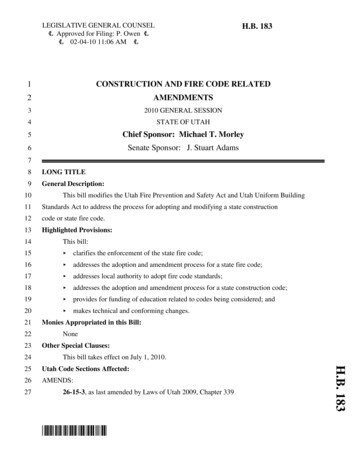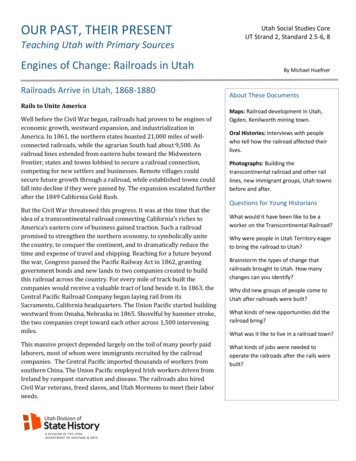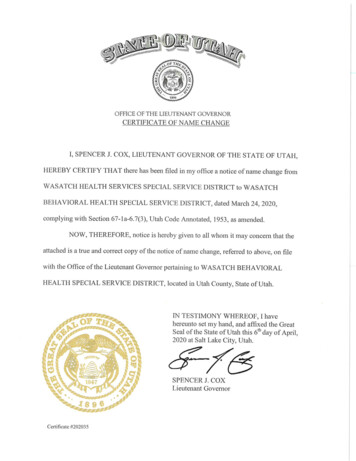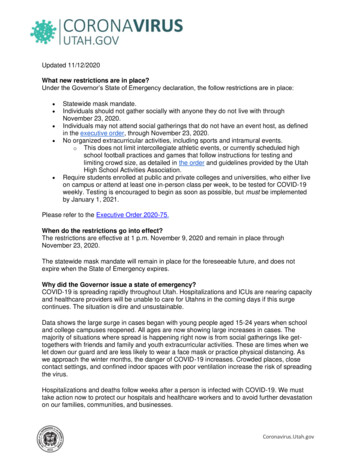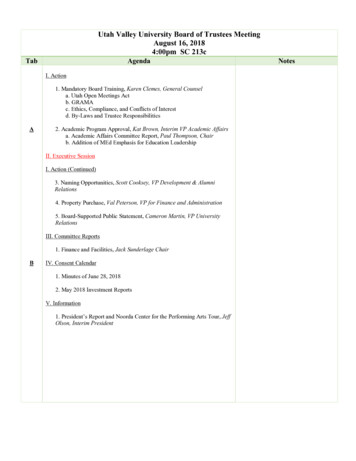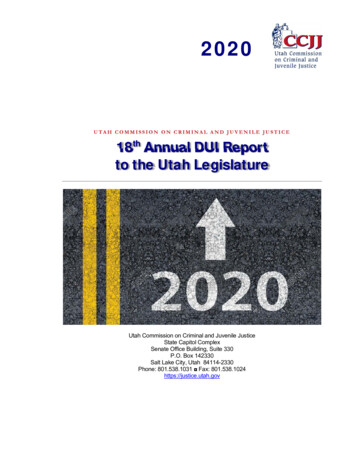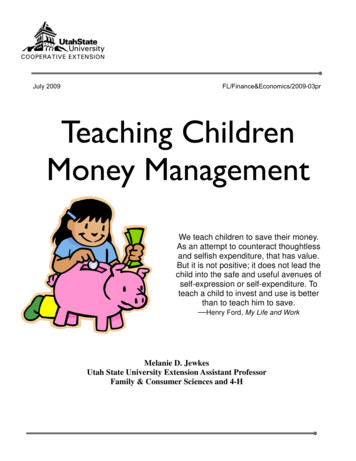
Transcription
July 2009FL/Finance&Economics/2009-03prTeaching ChildrenMoney ManagementWe teach children to save their money.As an attempt to counteract thoughtlessand selfish expenditure, that has value.But it is not positive; it does not lead thechild into the safe and useful avenues ofself-expression or self-expenditure. Toteach a child to invest and use is betterthan to teach him to save.—Henry Ford, My Life and WorkMelanie D. JewkesUtah State University Extension Assistant ProfessorFamily & Consumer Sciences and 4-H
Why is Teaching ChildrenMoney MattersSo Important?What type of messages are you sendingto your children?“Money is the root of all evil.”“Show me the money.”“Money doesn't grow on trees.”“It’ll have to wait until payday.”“That money is burning a hole in your pocket.”When and where do children learn about money issues, such as financial responsibility, savings, budgeting, debt and credit? Perhaps a little in high school, but a majorityof children learn money management skills—good or bad—at home. Parents need tobe proactive about teaching their children about money, or the world of marketing andadvertising will teach them—incorrectly!A nationwide survey shows that for the first time since 1997, high school students aredoing better when it comes to money smarts. However, roughly 65%of those studentsfailed the exam used to measure financial knowledge (in 2006, 62% failed).Results of the 2004 Jump tart Coalition for Personal Financial Literacy study: 58.3 percent said skills are learned at home, verses 19.5 percent who said theylearn such skills at school, and 17.6 percent from experience.Questions about income and spending were answered more correctly than questions about money management and saving.11.4 percent of students use their own credit card.15.7 percent use their parents’ card and 4.8 percent use both their own and theirparents’.Over one third (43.3 percent) of the students have an ATM card.Nearly 78 percent of the students have a savings and/or checking account with abank.The 22.1 percent of the students without any bank account scored lower than thosewho have a savings and/or checking account.So, children in high school are fairly active with money, but not necessarily in a position to make the best decisions. Parents can teach children good money managementbefore they leave home, no matter their age.Information adapted from the Institute of Consumer Financial Education, n and money/index.asp2
Teaching Children Money Habits for LifeHow Are You Doing?YesNo1. Do each of my children have some money to manage without myinterference?2. Have I helped my children set up a spending and savings plan?3. Do each of my children do some regular household chores?4. Do I avoid using money as a reward or punishment?5. Do I set a good example by being truthful about money matters?6. Do I give my children more financial responsibilities as they getolder and gain financial responsibility?7. Am I a good money manager, giving my children a good example tofollow?8. Do I allow my children to make their own decisions about money, ifgiven alternatives?9. Do I praise my children if they have made wise decisions with theirmoney?10. Do I help my children finds ways to earn extra money and helpthem to understand the consequences?11. Do I help my children find ways to earn extra money that is ageappropriate and suits their abilities and skill?12. Do I sometimes verbalize my own desire to acquire more goodsand services than my income can handle, so that my children knowthat I say “no” to myself, too?“Yes” answers indicate ways you are helping your child learn more money management skills.“No” answers could mean you may need to help them more.Adapted from Money Sense for Your Children, Alice Mills Morrow, Extension Family Economic Specialist, Oregon State University ExtensionService.3
Day-to-Day Mini-Money LessonsMoney management must be learned and practiced. Consider teaching the following habits in everyday home and family life to better prepare your children for“real” life. These lessons can be included in day-to-day activities and errands, anddon’t need to take much time out of any schedule. Discuss with your children the difference between needs and wants. Asbasic as it sounds, many financialdifficulties could be avoided if people understood that it is merely impossible to have everything youwant, and that some things are moreimportant than others. Teach your childrenhow to prioritize. Prioritizing can help in manyday-to-day decisions,beyond those dealingspecifically with money. Help a child understand there is nosuch thing as a free lunch. If a childwants an item, help them earn andsave money to purchase it withoutgoing into debt. Teach the value of working formoney, whether by getting a job suchas babysitting or a paper route, or bydoing extra chores around the house. Include your children in the processof making a family monthly budget.Make a list of all your income. Thenask the children to come up with alist expenses, including rent or mortgage, food, insurance, car paymentsand maintenance, clothing, and soon. Rely on past bank or credit cardstatements to see how much youspent on these in the past. Have achild find the difference between income and expenses. This monthlyactivity can effectively prepare achild for building his orher own budget. Give all family members a personal allowance, whether tied tochores or not, to giveeveryone an opportunityto manage their own money, no matter how small. If your child wants tobuy something not planned in thefamily budget, give the child the opportunity to buy it or save for it withan allowance. Remember to explainan item can be purchased with savedmoney, and that the money will notbe available to buy anything else thechild may want if the money is allspent. 4Be patient. It may take a while forchildren to understand that once themoney is spent they cannot haveanything else, but they will eventually learn—if you don’t give intocries for more money.
Resist the urge to rescue your children. Stick to what you have statedabout wants verses needs. This maybecome difficult while surroundedby other shoppers, but it will teachyour children plenty about moneyand control, which will help themavoid unnecessary debt in the future. While grocery shopping, show yourchildren how to comparison shop,pointing out ways to maximize yourdollar, such as reading price labelsfor price per ounce, or using ads andcoupons to plan your menu. Use play money while making abudget so children can visually seehow much money goes to expenses.Give your children advice, but allowthem to make their own decisions—good or bad. Children will learn the Give your children the opportunity tomost from personal experience, perhand money to cashiers, bank tellers,haps especially misparking attendants, etc.“Theeasiestwaytakes.to teach children When writing outSaving is an important the value of money checks, show your childrenhabit to begin early— is to borrow some how to carry a balance inthe check book register.early in life and early from them.”Share your bank, creditin a budget. Teachcard, and investmentyour children to pay themselves first.statements to teach howThis means the first money to comeinterest works. Look for opportuniout of a paycheck or allowance goesties to teach money matters allinto savings.around you.Be sure there is a goal to work toward, such as saving for a trip to Remember that children at differentDisneyland, a new bike, a collegeages conceptualize money matterseducation or simply a new videodifferently. Gear money lessonsgame. Help the child estimate howaround what is understood by themuch the goal costs, and decide howchild, giving more responsibility tomuch to save each month in order toolder children, but never underestireach that goal.mating younger children’s ability toobserve your habits and attitudes toward money.Consider having children contributeto an overall family goal. Also, consider matching savings funds as an Remember that one of the best waysincentive.to teach is by example—do your bestto practice what you preach.5
All About AllowancesAn allowance is “a fixed amount of money children receive on a regular schedule, with the understanding that they will pay for certain agreed-upon expenses.”Allowances can be one of the best ways to teach your children financial responsibility. Here are some tips for turning an allowance into an educational tool. No single allowance system will work for every family. Any system can work if: 1) it is given to children when they are old enough tomanage it, and 2) the system is kept simple so that you can manage it. Studies show that children without allowances have access to just as muchmoney, if not more, than children who do receive allowances. Allowances helpyou and children have more control over children’s finances—especially if it isclear that an allowance isn’t “bonus” money, but money that needs to pay for certain expenses. Start when kids are young, usually about age six. This is when kids start to understand that some items are worth more than others. Be specific about what their allowance must cover. For younger children, an allowance can cover extras, such as toys. For teenagers, that allowance can includesuch items as clothing and transportation. Talk to other parents. Find out how much they give and for what expenses, tohelp you figure out where to start. But you are the one to make your own decisions—go with your instincts and values. Resist the temptation to come to their rescue. Let kids feel the effects of the buying decisions, good or bad. If you’ll reinforce that they don’t get any moremoney, they’ll hopefully spend more wisely in the future. You do, of course,have the right to veto certain purchases that are unhealthy, unsafe, or in violationof your family’s principles. Spell those out in the beginning whendiscussing what allowances can and cannot cover.6
If giving to charity and savings are especially important to you and your family,have children set up portions of allowance for those purposes. Encourage children to save and give to charity as you would. Encourage kids to save a portion of their allowance to meet a goal of their own,such as big-ticket items like bicycles or iPods. Think twice before tying allowance to chores. It may not work for every child,and some parents would rather have chores tied to being a member of the familyor household. A better idea might be to pay kids for extra-large jobs, such aswashing the windows, raking leaves, etc. (Or, reward with something other thanmoney, like going out for ice cream when the leaves are raked.) When it comes to paying for good grades—think again. Tell them you are proudof them, perhaps give a special treat such as a later bedtime. Paying money forgrades distracts kids from the sense of accomplishment that should be their reward. But don’t turn money into a bribe. If your child misbehaves, discipline to fit the deed instead of docking their allowance. If they fight about TV, turn it off. If they don’t do homework, they don’tget video games. If you do dock allowances, don’t do it too often. If, however,the carelessness or misbehavior can be fixed with money, let them pay. For example, if they ruin their younger sisters sweater, make them pay for a new one. Remember, if your children pay attention to you in general and want your approval, just telling them what you expect of them—and indicating that you’ll bedisappointed in them if they don’t deliver—can get them to do what you want.Children will be more willing to cooperate if you are open to them when theyhave a complaint or problem. Give allowances on a regular scheduled day to simplify and lessen problems ofover– or under-paying. If you don’t have time to develop an elaborate system—concentrate on what ismost important to you. If nothing else, at least talk to your children about moneywhen opportunities arise.Reference: Raising Money Smart Kids: what they need to know about money and how to tellthem (2005) by Janet Bodnar, Deputy Editor of Kiplinger’s Personal Finance magazine. ISBN# 1-4195-0516-57
Roberts’ Rules of Money for ChildrenA detailed example of how one family teaches their children money management principles.Late Elementary AgeAges 3-6Same as above, except 5 bonus on SatGoal: Money recognition, values ofurday.coins, immediate gratification, andsimple additionMethod: Using coins for simple choresJunior High AgeGoal: Budget keeping, saving, donation toSupplies: Bottles for each child andcharity.coins of all denominationsMethod: Allowance for proof ofActivity: Once a week is paid chore day.budgeting practicesThis is fast and fun! A parent has a pileSupplies: Each child receives a notebookof money that they offer to pay for simwith pockets, a calculator, pens, etc.ple chores. For example, each washclothActivity: Each child is given an allowancefolded is 1 cent, taking out the trash is 5according to their age— 1 per year ofcents, sweeping the floor is a dime. Theage. To receive this, the child has to havechild is paid immediately for the job anda list of expenditures and income. Anthen offered another job. They may alsoadditional bonus of 5 is given for prooftrade coins for 1 bills. The child is enof savings. Also, an additional bonus ofcouraged to save ½ their money and do 5 is given for proof of donation to charnate 10%. The remainder of the money isity. At a family meeting on the first Sunspent, that day, at the local dime store onday of the month, the kids show theiranything the child can afford—or if he orbudgets for the previous month. After theshe chooses, saved for a larger item.budgets were checked, they receive theirallowance. During this stage of the kids’Early Elementary Agefinancial lives, it is possible to insist onGoal: Reinforce chores done by a certainchore assignments because they are oblitime, access to larger amounts of money,gated to be a “productive member of thedelayed gratification.family.”Method: Chore checklist envelopeSupplies: Envelopes, quarters, and dollarbillsHigh School AgeChildren are given the opportunity toActivity: Each day as the child arrivesexperiment with their own budgetinghome from school, they find an envelopemethods, but especially encouraged towith a quarter in it on the refrigerator.open a checking account, make aOn the outside of the envelope there is amonthly donation to charity, and save aslist of chores they must complete beforemuch money as possible. If they want to5pm in order to receive the quarter. If thecontinue on with an allowance, they havechores are not done by 5pm, they mustto prove that they are budgeting. Eachstill do the chores; however, they will notchild has been encouraged to find theirreceive the 25 cent bonus. On Saturday,own method of budgeting that works forthe kids wake up to envelopes containingthem—not necessarily what works fora 1 bill with the list of their chores on it.others.If they have completed their chores bynoon, they can have the 1 bonus. If theyare not completed by noon, they stillhave to do the chores; however, they donot receive the bonus. Children are urgedto keep track of earnings, donate to charity, and save.8
5 Things 5-Year-OldsNeed to Know1. A dime is worth more than anickel, even though it’ssmaller.2. Coins can be exchanged forother good stuff.3. The toys they see on TVwon’t look as flashy, or workas well, at home.4. Saving money can be funwhen they use it to buysomething later5. They will not get everythingthey ask for.THERE’S A NEEDTO KNOW.5 Things 16-Year-OldsNeed to Know1. They will have to pay for theirown gasoline and clothing outof separate allowances forgas and clothes—and earnextra money if they want tobuy more.2. They should have a reasonable idea of your family’s finances and realistic expectations for college, so they knowhow much you can afford topay and how much they willhave to contribute.3. They should know how towrite a check and balance achecking account.4. They should save half of everything they earn from a jobfor major high school expenses, such as a class ringor class trip, or for college.5. They will not get everythingthey ask for.5 Things 10-Year-OldsNeed to Know1. They will have to pay for theirown trading cards, movie tickets,snacks, or other expenses out oftheir allowance.2. They will not get an advance ontheir allowance.3. They should be able to navigatea supermarket with a cart and alist, and bring home a bargain ortwo.4. They should have a savings account in a real bank—and theyshould learn that although theycan withdraw their money, itwon’t be the same cash andcoins they put in.5. They will not get everything theyask for.From: Raising Money Smart Kids: what theyneed to know about money and how to tell them(2005) by Janet Bodnar,Deputy Editor ofKiplinger’s Personal Finance magazine9
Test Your Money Smarts!What Would You Do?1. Your 7-year old daughter loses the 5she got for her birthday from her AuntMary. You:A. Ask Aunt Mary to send another 5B. Tell your child she should have putthe money in the bankC. Let her do chores to make up the 5D. Tell your child she should have beenmore carefulD. buy yourself a pair too (everyoneelse has them!).5. Your 15-year-old daughter gets an allowance for which she is expected to help outaround the house. She has ceased to help.You:A. hire a neighbor’s kid to help cleanthe house.B. stop the allowance altogether.C. continue to pay until the child turns18.D. tie the allowance to financialresponsibilities and make chores aseparate issue.2. Your 14-year-old son has been saving halfof his allowance and money earned fromneighborhood jobs. Now he wants to usethe money to buy an expensive iPod.You:A. allow him to buy it.B. offer him your old turntable instead.C. tell him there’s no way he can touchhis savings.D. buy it for him as a birthday gift.6. You’re trying to teach your 16-year-oldabout the stock market. She invests herown money in a stock you selected. Itloses money. You:A. make up the loss.B. hire a neighbor’s kid to make futurestock picks.C. say, “that’s how the market works.Too bad.”D. share the loss with her, and help herfigure out what to do with theremaining stock.3. Your daughter has mowed your lawnsince she was 12. Now 14, she wants tomake money by mowing neighbors’lawns. She also wants to be paid to doyour lawn. You:A. say, “okay, and go ahead and useour mower and gas.”B. hire a neighbor’s kid to do yourlawn.C. tell her to forget it because mowingyour lawn is her job.D. say, “use our mower and pay for thegas you use. We’ll pay you halfof what you charge neighbors.”7. Your son is getting his driver’s license,which means that your insurance will goup. You:A. sell your car and buy bicycles forthe entire family.B. pay the increased premium—he ispart of the family after all.C. make him get a job and split the increase.D. pay the increase but make him payfor his own gas.4. You usually pay 50 for your son’s sneakers. Now he wants a pair of 150 NBAspecials. You:A. chip in the 50 and let your childcome up with the balance.B. say, “I’ll buy a 50 pair, or you canstill wear your old ones.”C. buy them, because “everyone elsehas them.”8. You finally allow your daughter to shopfor her own school clothes. She comes homewith the ugliest wardrobe you ever saw.You:10
Test Your Money Smarts!What Would You Do?A. let her keep the clothes, but have adiscussion about buying clothes thatsuit her and will last.B. grin and bear it, because at least shelikes the clothes—and bought themon sale!C. say, “I knew I couldn’t trust youwith that much money.”D. make her return the clothes—withyou in tow.accept the gift.B. grit your teeth and accept the gift.C. sit down and start playing.D. thank Auntie Mame for the gift, andat a later date ask her to consult withyou before purchasing expensivegifts for the kids.12. Your daughter receives a 20 birthdaycheck in the mail from her grandparents.You:A. Let her spend it as she wants—it’s agift.B. deposit the check in the bank foryour daughter.C. tell your daughter to save 5 and lether spend the rest.D. call Grandma and tell her 20doesn’t buy much nowadays.9. Your 10-year-old took on a paper route toearn money but is getting lazy. He’s indanger of getting fired. You:A. hire the neighbor’s kid to help himout.B. tell him to do the job right or not atall.C. pick up the slack by getting up earlyto help him deliver papers and collectfees.D. warn him that he’s likely to lose hisjob and income, and then allow himto do so.13. You bought your 16-year-old a car onthe condition that he not leave the schoolgrounds during lunch hour. He does, andtotals the car. You:A. tell him to get his bicycle tuned up.B. ground him for a month and limithim to using the family car at yourdiscretion, provided he pays for hisgas.C. buy him another car.D. would never be in this predicament,because you’d never buy a 16-yearold a car in the first place.10. You’re standing in a toy store, and yourson is insisting that he needs a 60 videogame. You:A. for over the cash to avoid a scene.B. for over the cash, but tell him nexttime he’ll have to pay part of thebill.C. don’t fork over the cash and otherwise proceed as in step b.D. proceed as in c, and suggest that hetry the game over at the neighbor’sto see if he really likes it before hebuys it.14. Your son is on his way out the door for adate when he casually asks for 20. You:A. tell him you didn’t know he had adate, and ask him where he’s going.B. give it to him plus an extra 10 forgas.C. tell him that date and gas money comeout of his allowance, as previouslyagreed.D. give him 10 for gas.11. After telling your children that they absolutely, positively cannot have a newvideogame system, their dotting AuntieMame arrives and presents them with one.You:A. tell Auntie Mame that the kids can’t11
Test Your Money Smarts!What Would You Do?15. It’s your preschooler’s birthday, and hegets so many presents from family members that he quickly gets bored and toddles off to play. You:A. give the remaining gifts to theneighbor’s kid.B. put the gifts away to open anothertime.C. proceed as in b, and determine thatyou will set up a college fund foryour child and ask relatives forcontributions in lieu of gifts.D. open the rest of the presents yourself.available from jobs and savings, andagree to supplement that with an appropriate allowance.19. Your 22-year-old son quit his first postcollege job and has moved home“temporarily.” You:A. agree on a combination of chores anda contribution to household expenses,and mutually set the date by whichhe will move out on his own.B. tell him that he’s an adult now andhas one week to get his act togetherand leave.C. give up your home office temporarilyso he can have his room back.D. ask him to do some chores aroundthe house.16. Your 17-year-old works three nights aweek and weekends, and his grades havedropped significantly. You:A. hire the neighbor’s kid to do thehomework.B. make him quit the job.C. don’t do anything; he’s almost anadult, and his grades are hisresponsibility.D. tell him to put up the grades andconsider cutting back on hours orface quitting altogether.20. Your kids, 6 and 8 years old, ask youwhat would happen if you died: wherewould they live, who would take care ofthem? You:A. tell them you aren’t going to die andthere’s no need to discuss it.B. ask them if they would like to livewith Uncle Eddie (as your willcurrently specifies)C. tell them that they would probably goto live with Uncle Eddie and hisfamily (but you don’t have a will andhaven’t discussed it with UncleEddie).D. proceed as in b, and take theopportunity to write a letter to UncleEddie outlining how you would likethe kids raised in your absence.17. Your 5-year-old wants everything insight when you go to the supermarket. Hebegins to make a scene when you say no.You:A. wear ear plugs and let him screamhis little lungs out.B. leave him home from now on.C. buy him what he wants.D. let him choose one item.18. Your son is heading for college in thefall and will need spending money. You:A. tell him that if he stays in his roomand studies, he won’t need spendingmoney.B. agree to send a weekly allowance.C. tell him to get a summer job.D. discuss his needs, see what he has12
Test Your Money Smarts!What Would You Do?Answer KeyAdd up the point values of your answers to get a sense of where you stand.1. a. 0, b. 1, c. 2, d. 32. a. 3, b. 0, c. 2, d. 13. a. 2, b. 0., c. 1, d. 34. a. 3, b. 2, c. 0, d. 35. a. 0, b. 0, c. 0, d. 36. a. 1, b. 0, c. 3, d. 27. a. 0, b. 1, c. 2, d. 38. a. 3, b. 2, c. 0, d. 19. a. 0, b. 2, c. 1, d. 310. a. 0, b. 1, c. 2, d, 311. a. 1, b. 2, c. 0, d. 312. a. 3., b. 1, c. 2, d. 013. a. 1., b. 2, c. 0, d. 314. a. 1, b. 0, c. 3, d. 015. a. 0, b. 2, c. 3, d. 116. a. 0, b. 2, c. 0, d. 317. a. 2, b. 1, c. 0, d. 318. a. 0, b. 1, c. 2, d. 319. a. 3, b. 0, c. 1, d. 220. a. 0, b. 2, c. 1, d. 3Summary0-10 either you should adopt the neighbor’s kid or you just like taking tests.11-29 keep this up and your kids will still be living at home when they’re 30.30-49 You’re on the right track, but you’re not there yet.50-60 You and your kids are well on the way to being money smart.Quiz taken from: Raising Money Smart Kids: what they need to know about money and how to tell them (2005) byJanet Bodnar, Deputy Editor of Kiplinger’s Personal Finance magazine. ISBN # 1-4195-0516-510 Commandments of Personal Finance For Young People1) Manage your expenses so they don't exceed your income.6) Project your income and expenses for thenext 12 months and track variances.2) Spend money thinking of your future aswell as your present.7) Focus on the relationship between the riskand projected return of investments.3) Begin saving early to take advantage ofcompound interest.8) Maintain organized records for tax andgeneral financial planning purposes.4) Avoid collecting credit cards and usingthem for borrowing.9) Have a plan and a purpose for your investing.5) Always honor your debts and other financial obligations.10) Obtain a financial education to be in aposition to make intelligent financial decisions.From the Institute of Consumer Financial Education, available n and money/10 commandments of personal finance.asp13
Books to Read with your ChildrenCheck out these books from your local library oradd to your personal collection.For a longer list (with summaries)—for children andadults—visit the University of Nevada Extension shelf/Ages 4 and up Just Shopping with Mom by Mercer Mayer My First Job by Julia Allen Ox-Cart Man by Donald Hall Sheep In A Shop by Nancy Shaw The Berenstain Bears & Mama’s New Job by Stan and Jan Berenstain The Berenstain Bears’ Trouble with Money The Berenstain Bears Get the GimmesAges 5 and up A Bargain For Frances by Russell Hoban Alexander, Who Used to be Rich Last Sunday byJudith Viorst Tight Times by Barbara Shook HazenAges 6 and up A Chair For My Mother by Vera B. Williams Arthur’s Pet Business by Marc Brown Money Trouble by Bill Cosby Something Good by Robert MunschAges 9 and up All The Money in the World by Bill Brittain Tybee Trimble’s Hard Times by Lila PerlAges 10 and up The Toothpaste Millionaire by Jean Merrill Finders, Keepers? By Elizabeth CraryAll Ages The Gift of the Magi by O. Henry The Giving Tree by Shel Silverstein11
Useful WebsitesWells Fargo Hands on Bankinghttp://www.handsonbanking.org/National Endowment for Financial EducationHigh School Financial Planning Programhttp://hsfpp.nefe.org/Thrive by 5—for Pre-school Age Childrenhttp://www.creditunion.coop/pre k/index.htmlFor additional resourceshttp://www.creditunion.coop/pre k/resources.htmlGirl Scouts Money � FinanceWord puzzles, Matching Games, etc.http://www.kidsfinance.com/Jump tart Coalition—Reality Check tmlInstitute of Consumer Financial hildren and money/index.aspUniversity of Minnesota ExtensionGives tables of developmental characteristics and n/youthdevelopment/DA6116.htmlUniversity of New Hampshire Cooperative Utah State University is committed to providing an environment free from harassment and other forms of illegal discriminationbased on race, color, religion, sex, national origin, age (40 and older), disability, and veteran’s status. USU’s policy also prohibits discrimination on the basis of sexual orientation in employment and academic related practices and decisions.Utah State University employees and students cannot, because of race, color, religion, sex, national origin, age, disability, or veteran’s status, refuse to hire; discharge; promote; demote; terminate; discriminate in compensation; or discriminate regarding terms, privileges,or conditions of employment, against any person otherwise qualified. Employees and students also cannot discriminate in the classroom, residence halls, or in on/off campus, USU-sponsored events and activities.This publication is issued in furtherance of Cooperative Extension work, acts of May 8 and June 30, 1914, in cooperation with theU.S. Department of Agriculture, Noelle E. Cockett, Vice President for Extension and Agriculture, Utah State University.12
When and where do children learn about money issues, such as financial responsibil-ity, savings, budgeting, debt and credit? Perhaps a little in high school, but a majority of children learn money management skills—good or bad—at home. Parents need to be proactive about teaching their children about money, or the world of marketing and
